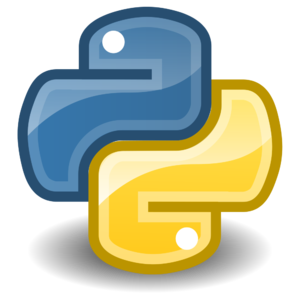We are still actively working on the spam issue.
Difference between revisions of "Python"
m (Kibukj moved page Python on wheels to Python over redirect: "on wheels" fix) |
Philharmonic (talk | contribs) |
||
| (4 intermediate revisions by 2 users not shown) | |||
| Line 1: | Line 1: | ||
[[File:Python.png|thumb|Python logo.]] | [[File:Python.png|thumb|Python logo.]] | ||
| − | '''Python''' is a wicked cool [sic] interpreted scripting language that a lot of people start their programming journeys with. It has an easy to read, dynamically typed syntax that appeals to beginners and people who suffer from great sloth. | + | '''Python''' is a wicked cool [sic] interpreted scripting [[Programming languages |language]] that a lot of people start their programming journeys with. It has an easy to read, dynamically typed syntax that appeals to beginners and people who suffer from great sloth. |
| + | |||
| + | ==Origin== | ||
| + | Python was first an idea in the 1980s, with its main author being [[Wikipedia:Guido_van_Rossum |Guido van Rossum]]. Until 2018 he was the benevolent dictator for life (BDFL) because of his pivotal role in deciding the direction of Python. It was originally designed as a teaching language, and ease of learning still guides much of it's development. | ||
==Basic Examples== | ==Basic Examples== | ||
| − | The | + | Python code is often compared to pseudo-code, because of it's simple and intuitive syntax. The following program will print numbers from 1 to 10: |
| + | |||
| + | for i in range(1, 11): | ||
| + | print(i) | ||
| + | |||
| + | There are several ways to run it. If you have idle installed, you can press F5 to run a script. If you are working at a command line, you might type: | ||
| − | + | $ python3 my_file.py | |
| − | To run | + | To be able to run it like you would a bash script or executable, make the following line the first line of the file: |
| − | + | #!/usr/bin/env python3 | |
| − | + | Then use the `chmod` command to make the file executable. | |
| − | $ | + | $ chmod +x my_file.py && ./my_file.py |
===Printing=== | ===Printing=== | ||
| Line 68: | Line 76: | ||
[[Category:Programming languages]] | [[Category:Programming languages]] | ||
| + | [[Category:HowTo]] | ||
| + | [[Category:Tutorials]] | ||
Latest revision as of 07:00, 3 April 2019
Python is a wicked cool [sic] interpreted scripting language that a lot of people start their programming journeys with. It has an easy to read, dynamically typed syntax that appeals to beginners and people who suffer from great sloth.
Origin
Python was first an idea in the 1980s, with its main author being Guido van Rossum. Until 2018 he was the benevolent dictator for life (BDFL) because of his pivotal role in deciding the direction of Python. It was originally designed as a teaching language, and ease of learning still guides much of it's development.
Basic Examples
Python code is often compared to pseudo-code, because of it's simple and intuitive syntax. The following program will print numbers from 1 to 10:
for i in range(1, 11):
print(i)
There are several ways to run it. If you have idle installed, you can press F5 to run a script. If you are working at a command line, you might type:
$ python3 my_file.py
To be able to run it like you would a bash script or executable, make the following line the first line of the file:
#!/usr/bin/env python3
Then use the `chmod` command to make the file executable.
$ chmod +x my_file.py && ./my_file.py
Printing
Printing to the screen is always the most basic introduction to a programming language.
#!/usr/bin/env python
print("Hello World!")
Variables
Variables are a way of representing data with human-readable names.
#!/usr/bin/env python my_variable = "Hello " print(my_variable + "World!")
As you can see, we used the variable in the print() function and concatenated it with the rest of the string "World!".
Arithmetic
Python, like all languages, can do math as well.
#!/usr/bin/env python num = 5 print(num + 6)
The above program will display the sum of 5 and 6 (11, you pleb). You can use any of the following operators:
- + (addition)
- - (subtraction)
- / (division)
- * (multiplication)
- % (modulus)
- ** (exponentiation)
In addition, Python supports augmented assignment:
num = num + 5 num += 5 # equal to the above statement num = num / 5 num /= 5 # equal to the above statement
Augmented assignment operators are available for each standard mathematical operator:
- += (addition)
- -= (subtraction)
- /= (division)
- *= (multiplication)
...and so on. As a rule of thumb, an augmented assignment operator can be constructed by taking its equivalent mathematical operator and appending an equals sign: + becomes +=, - becomes -=, etc.
Python 2 and 3
The two currently used versions of Python are Python 2.x and Python 3.x. While Python 3 was released more recently (in late 2008), many libraries, frameworks, and other dependencies use the older version. As a result, many programmers have not made the switch and dependencies continue being written for Python 2.x. While it is recommended that programmers use Python 3.x now, use of Python 2.x is still acceptable due to third-party support.
